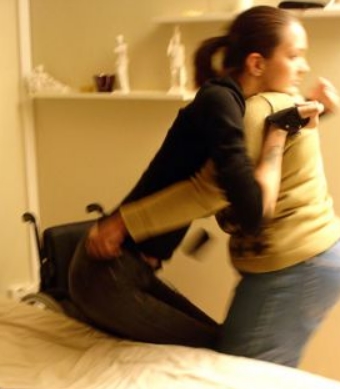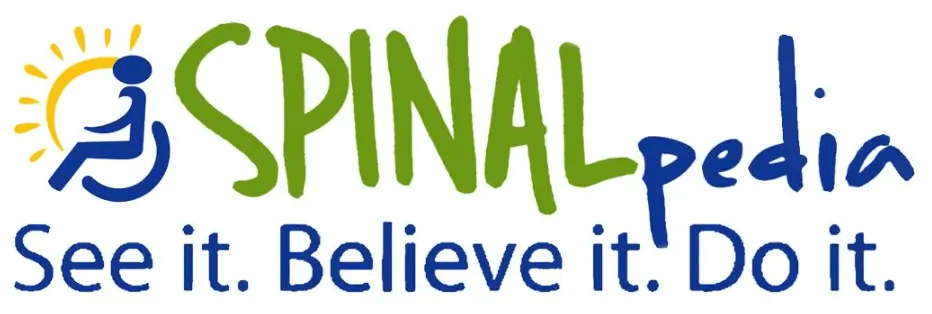 Even though you’re going home in a wheelchair, you still need to work your butt off in therapy to be as strong as possible. Most go to the hospital gym (rehabilitation) and work with their therapists for several months. Doing this helps you become as independent as possible so you’re ready to live when you return home.
Even though you’re going home in a wheelchair, you still need to work your butt off in therapy to be as strong as possible. Most go to the hospital gym (rehabilitation) and work with their therapists for several months. Doing this helps you become as independent as possible so you’re ready to live when you return home.
You may not believe it, but you can still live a full and happy life in a wheelchair. Thousands of people do every day, but doing your best in rehab is your first step.
Who Will You See in Rehab?
In rehab, you will see two different therapists – a physical therapist (definition: licensed health care professionals who can help patients  reduce pain and improve or restore mobility) and an occupational therapist (definition: a health professional whose goal is to help people achieve independence, meaning and satisfaction in all aspects of their lives).
reduce pain and improve or restore mobility) and an occupational therapist (definition: a health professional whose goal is to help people achieve independence, meaning and satisfaction in all aspects of their lives).
An occupational therapist works with your arms, hands and fingers, helping you figure out how did you everything you used to do before with your upper body. For many people with spinal cord injuries, they can move their arms but not their hands. These folks need to re-learn how to do everything from writing to opening that tricky bar of chocolate. Occupational therapists help you figure this stuff out.
A physical therapist works with your legs and your wheelchair. They help with a lot of things from teaching you how to push your wheelchair to helping you practice your balance on a mat.
Transfers – Getting In and Out of Your Wheelchair
Physical therapists will also help you learn how to get in and out of your wheelchair. From getting into cars, beds, couches and more, this is called a transfer  (definition: the act of moving from a wheelchair to another place to sit or lay) and they will help you figure out how to do this solo if it’s still possible. They can also show your friends and family how to help you.
(definition: the act of moving from a wheelchair to another place to sit or lay) and they will help you figure out how to do this solo if it’s still possible. They can also show your friends and family how to help you.
Transferring safely is very important. You don’t want to get injured while moving to and from your wheelchair. You can get dropped and break something or worse. Many use a transfer board (a plastic board you sit and slide on) to make their transfers easier. And others will use mechanical lifts if they need help from someone else.
The most popular transfer when you need help is being lifted, and there is a right way to do it. Many people who help lift people with spinal cord injuries hurt their backs. It’s important to learn the right way how to do it.To see a safe transfer, watch the video below. Afterwards, please read the Takeaway Points.
Video: Quadriplegic C5-C6 bed transfer
Takeaway Points:
- Have a stable base before transferring/apply brakes
- Angle wheelchair towards the bed
- Bring butt to edge of wheelchair before transferring
- Use your away arm to push and initiate the transfer
- Make sure the wheelchair is level with the bed (or wherever you’re going)
- A gait belt or transfer board can help
Helpful Links:
- Understanding Spinal Cord Injury: Part 2 – Recovery and Rehabilitation (PDF) – UAB-SCIMS – http://www.msktc.org/lib/docs/Factsheets/SCI_Understand_Spin_Crd_Inj_Prt2.pdf
- Safe Transfer Technique (PDF) – UABSCIMS – http://www.msktc.org/lib/docs/Factsheets/SCI_Safe_Transfer_Techniques.pdf
Do you need knowledgeable community support for yourself or a loved one who is in the hospital or just returned home with a spinal cord injury? Our team of peer mentors can help you navigate the resources available to you as well as avoid common pitfalls around fundraising and disability benefits. C4-5 quadriplegic Josh Basile, C7 quadriplegic Jonathan Sigworth, and T6 Paraplegic Rose Dougherty have years of lived experience with SCI and have helped thousands navigate the path to independence during and after rehabilitation. Schedule a FREE video call today by clicking on the following link: https://bit.ly/SPINALpediaNewlyInjured










